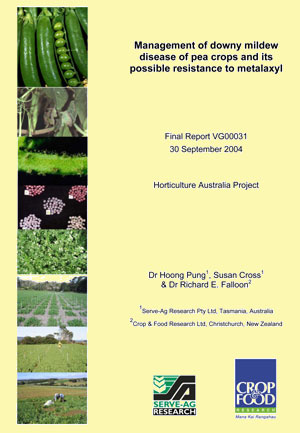|
Metalaxyl seed treatment had been used successfully for many years for the control of downy mildew on pea seedlings.
In recent years, poor crop establishment, severe crop infection and yield loss due to downy mildew on processing pea crops have became more frequent in Australia, and fungicide resistance in the downy mildew pathogen was suspected.
This project aimed to determine:
- whether Peronospora viciae strains in Australia were resistant to metalaxyl
- to identify suitable alternative seed treatments for the control of metalaxyl resistant downy mildew
- develop affordable treatment methods for field downy mildew control.
Authors
|
| Hoong Pung |
Susan Cross |
| Richard Falloon |
|


Results :
1. Sensitivity of Peronospora viciae to metalaxyl-M
- A total of 16 collections of P. viciae were obtained from pea crops at different sites in northern Tasmania for bioassay tests in 2001.
- Thirty-eight % of the collections were sensitive to metalaxyl, 31% were resistant and another 31% were partially resistant.
- This was consistent with similar resistance development in New Zealand. This is the first report of metalaxyl resistance following its use as a pea seed dressing for downy mildew control in Australia.
2. Seed and seedling infection control
- This project demonstrates the importance of seedborne infections and seedling pathogens, as well as the effectiveness of seed dressings with several active ingredients, in controlling several major pathogens and diseases of pea.
- Fungicide seed dressing is the most cost effective method of controlling seedborne infections and early seedling diseases.
- With the establishment of metalaxyl-resistant isolates of P. viciae in Tasmania, fungicide resistance management strategies for seed treatment should include alternating metalaxyl or phenylamides with chemicals that have different modes of action, or using metalaxyl in mixtures with non-phenylamide chemicals.
3. Field downy mildew control
- Downy mildew and Ascochyta collar rot are the two most common and important diseases of processing pea crop that impacts on pea yield and quality.
- Prior to this project, there was no effective or affordable control method for field downy mildew, hence, the impact of downy mildew field infection on pea yield was unknown.
- In this project, with effective field control, yield increases of 1 to 3 tonnes per hectare were recorded following improved downy mildew control.
- As for collar rot, yield increases of 1 to 2 tonnes per hectare were recorded following reduced collar rot severity with Bravo applications.
- This project identified three low cost fungicide products, chlorothalonil (Bravo), mancozeb (Penncozeb), and phosphorous acid (Agri-Fos), that provided effective control methods for field downy mildew on processing pea crops.
- The timing of the fungicide applications was critical. Early fungicide applications, before diseases occur, only protect plants for a short interval of 10 to 14 days. Therefore, for optimum downy mildew control, the fungicide application must be applied at the first sign of infection in a crop.
- Downy mildew field infections usually occur at the pea growth stage of 6 to 8 nodes, depending on sowing time and weather conditions.
Acknowledgments :
The funding of this project by Horticultural Research and Development Corporation, processing pea growers, Simplot Australia Pty Ltd, McCain Foods (Australia) Pty Ltd and Syngenta Pty Ltd, is gratefully acknowledged.
We would also like to thank all the growers and field officers from Simplot Australia Pty Ltd and McCain Foods (Australia) Pty Ltd, who assisted in the project studies.
Lyndon Butler and Vaughan Trebilco of Forthside Vegetable Research Station are acknowledged for their assistance in the seed treatment trials at the station, and for allowing us to use the mechanical pea viner and pea maturometer.
Serve-Ag Research staff who assisted in this project are Sarah Lamprey, Pam Cox, Belinda Mathews, and Rebecca de Courcy.
|

